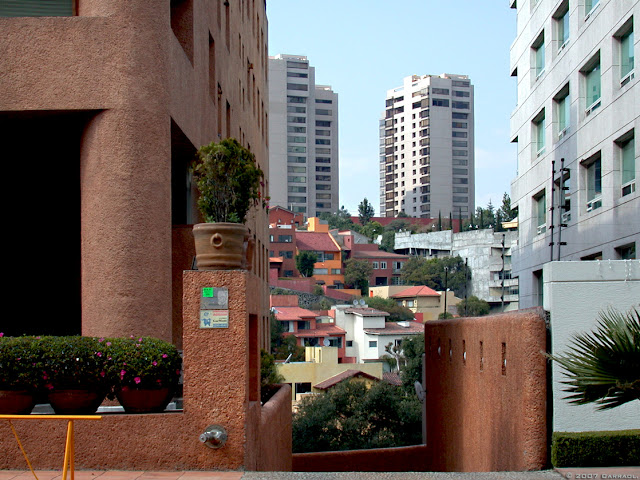
Tarde lluviosa en Bosque de las Lomas [ Stormy afternoon at Bosque de las Lomas ]
The Magic of the Cities.
Zen promotes the rediscovery of the obvious, which is so often lost in its familiarity and simplicity. It sees the miraculous in the common and magic in our everyday surroundings. When we are not rushed, and our minds are unclouded by conceptualizations, a veil will sometimes drop, introducing the viewer to a world unseen since childhood. ~ John Greer
Teotihuacán is one of the major tourist attractions in Mexico City – a place that’s full of attractions. I urge you to go. It’s easy to get to. There are decent eating places out there and lots to see and do. There’s a museum and a cultural center and plenty of places to buy souvenirs. And if you’re feeling energetic, try the climb up to the top of either pyramid. At the very summit of the Pyramid of the Sun there’s a metal spike sticking up an inch or so out of the stone. Do what everyone did when we were up there - hold on to it and let the Pyramid’s energy flow into your body.
If you go with an experienced guide, one who knows his or her stuff, there’s lots to learn and see and think about. But if you just want to visit and take in the ambiance of one of the world’s great archaeological sites, then Teotihuacan is still enjoyable and rewarding.
Alan Cogan.

Teotihuacan arose as a new religious center in the Mexican Highland, around the time of Christ. Although its incipient period (the first two centuries B.C.) is poorly understood, archaeological data show that the next two centuries (Tzacualli to Miccaotli phases; A.D. 1-200) were characterized by monumental construction, during which Teotihuacan quickly became the largest and most populous urban center in the New World. By this time, the city already appears to have expanded to approximately 20 square km, with about 60,000 to 80,000 inhabitants (Millon 1981:221). The development of the city seems to have involved inter-site population movements, exploitation of natural resources, an increase in agricultural production, technological inventions, establishment of trading systems and other kinds of socio-political organizations, and attractive belief systems. By the fourth century, unmistakable influences of Teotihuacan were felt throughout most parts of Mesoamerica. Teotihuacan was the sixth largest city in the world during its period of greatest prosperity, according to an estimated population of 125,000 (Millon 1993:33). The city seems to have functioned for centuries as a well-developed urban center until its rather sudden collapse, possibly in the seventh century. The place was called Teotihuacan by Nahuatl speakers several centuries after the city's fall, but its original name, the language or languages spoken there, and the ethnic groups who built the city are still unknown.
Saburo Sugiyama: Arizona State University, Dept. of Anthropology, Tempe, AZ 85287 ©Copyright 1996 Project Temple of Quetzalcoatl, Instituto Nacional de Antropología e Historia, Mexico/ ASU

Thanks for the tip to enlarge the photos to: Dsole, Arradon, Ming
If you want to post the larger format:
1-Upload a photo as you usuall do.
2-Then click on the "edit HTML" icon.
3-You will see something that starts like this: src="http://4.bp.blogspot.com/.../s400
4-Change s400 to s640.
Then, open Template:
1-Go down to "Header". Change "width:660px;" to "width:880px;"
2-Go down to "Content". Change "width:660px;" to "width:880px;"
3-Go down to "Sidebar". Change "width:220px;" to "width:180px;"
4-Try with "preview" to see if it's ok.